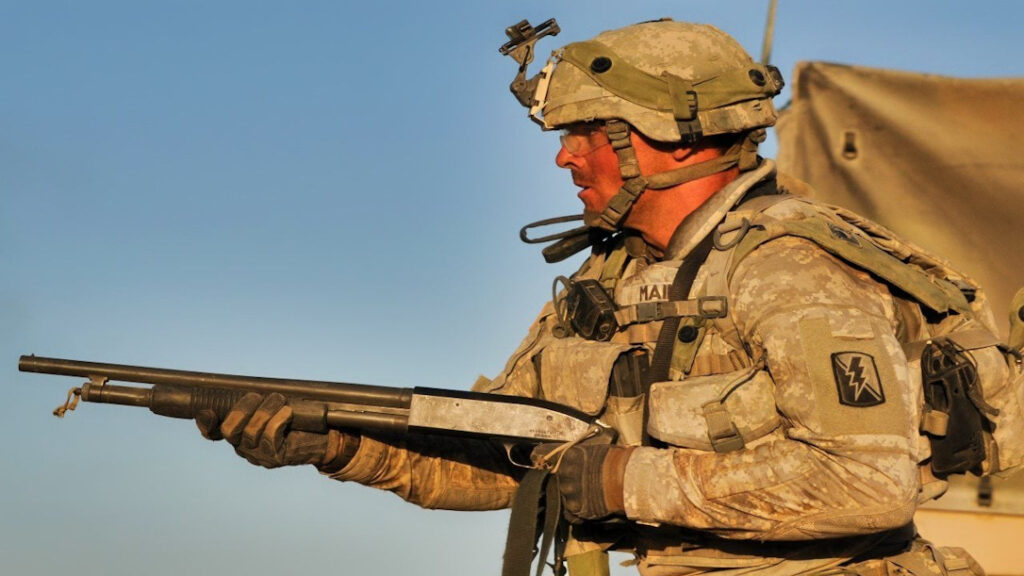As a disciple of the gauge, I’ve experimented with quite a few different sighting systems for shotguns. The basics like beads and ghost rings, as well as red dots and even a 1X prism optic at one point. If we take optics out of the conversation, what’s the best set of sights for a shotgun? Ghost rings are popular, and bead sights are extremely popular, but one sighting system that has sadly taken a backseat to both is barrel-mounted rifle sights.

Rifle sights on a shotgun were quite popular back in the day. Police forces commonly used them when Ithaca 37s were popular. They were a frequent addition to hunting shotguns, specifically shortish-barreled shotguns like the Winchester Model 12 and 1200/1300, as well as the aforementioned Ithaca Deerslayer. Mossberg and Remington both used to make various models with rifle-type sights.
Advertisement — Continue Reading Below
Then all of a sudden, they seemingly disappeared. Finding a modern production shotgun with a barrel-mounted set of rifle sights isn’t easy. Hell, it might not be possible. I think that’s a shame.
What are Barrel Mounted Rifle Sights?
These sighting systems place an open rear sight near the rear of the barrel and a rifle-style front sight. Why are they called rifle sights when they are technically shotgun sights? Well, the design comes from Safari-style rifles that placed nearly identical sights on the barrel for rapid and accurate shooting of dangerous game.

Advertisement — Continue Reading Below
Shotguns picked up on the same sights for basically the same reason. You could argue for a rear sight placed on the receiver for a longer sight radius, but the forward-mounted rear sight has some benefits. It’s faster and easier to see on the barrel. Also, it likely made production easier. You make the same receiver with different barrels rather than make different receivers.
The Benefits of Rifle Sights (On Shotguns)
I recently got my hands on an Ithaca Deerslayer and a Model 1300 with rifle sights and did a little testing against beads and ghost ring sights. I had curiosity about why these sights seemingly disappeared from the market and assumed they were something used by hunters and no one else, specifically, those guys using slugs. Most slug gun shooters I know have now turned wholeheartedly into low-power optics.

Advertisement — Continue Reading Below
After banging out a variety of birdshot, buckshot, and slugs, I was pleasantly surprised by how capable and handy rifle sights on a shotgun were. They were extremely fast when needed and could be quite precise as well. The argument between a bead and ghost rings is speed versus precision, but why can’t you have both?
Rifle sights on shotguns seemed to offer me the best of both worlds. I could ignore the rear sight entirely and find the front sight, as if it was a bead, and let loose with speed. If I needed to slow things down, I precisely set the front sight between the rear sight and let the round fly.
What About Dots?
We can’t ignore optics, and in a world where Scalarworks Sync mounts exist and red dots are common, why wouldn’t we use a dot? Red dots, much like rifle sights, are both fast and precise and the clear best option for shotguns. However, why not both?
Advertisement — Continue Reading Below

The barrel-mounted sights occupy no receiver space, which means you can use a red dot and barrel-mounted irons with no logistic issues. Plus, the irons will likely co-witness without issue depending on your mount height and attachment design. On a Sync mount or similar, there certainly aren’t going to be any issues.
Sighting In
Sights on shotguns, especially tactical shotguns, are important. If you’re busting clays, a bead works, but for a defensive shotgun, you might need to be a bit more picky. It’s a shame that rifle sights have seemingly disappeared on modern shotguns. Now to have that sort of setup, you’ll need a gunsmith who can make it happen.
Advertisement — Continue Reading Below
It’s unlikely we’ll see a rifle sight comeback, but I’ll keep my hopes up. Slightly.















